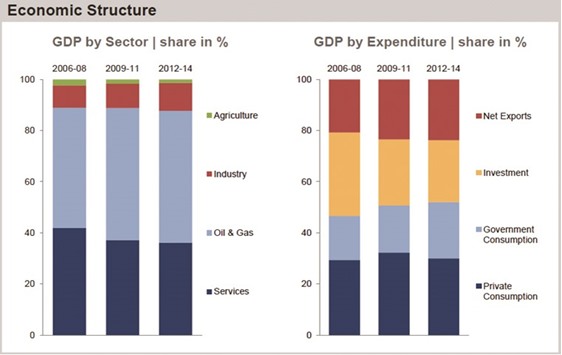Qatar’s “commitment” to severe fiscal adjustment, coupled with remarkable diversification efforts is “positively supporting” growth, shows a new report that sees the local economy growing 4.1% this year and 4.2% in 2017.
Qatar, which enjoys a relatively diversified economy compared to its regional peers, is expected to be the “best performer in 2016”, said Focus Economics in its ‘Consensus Forecast’ for Mena.
Despite weaker activity in the oil and manufacturing sectors, the Qatari economy expanded a robust 4% in Q4, 2015, said Focus Economics citing preliminary data released by the Ministry of Development Planning and Statistics (MDPS).
This, it said, came in below the 3.8% expansion tallied in Q3, and was mainly driven by solid increases in the non-mining and quarrying sector.
The figure indicates that the government’s commitment to severe fiscal adjustment, coupled with remarkable diversification efforts, is positively supporting growth.
According to Focus Economics, the knock-on effects of a less benign fiscal environment are likely to be muted by the development of new natural gas plants and crude oil refineries.
Analysts see the economy growing 4.1% in 2016, which is down 0.1 percentage points from last month’s estimate. For 2017, panellists foresee growth of 4.2%.
Qatar’s inflation came in at 3.6% in February, which was up from January’s revised 3.1%. Panellists expect inflation to average 2.5% in 2016. For 2017, the panel sees inflation averaging 2.8%.
In its ‘regional outlook’, Focus Economics said despite the rally observed in recent weeks, oil prices remain at very low levels, which does not bode well for economic activity in the region, particularly among oil-export-driven economies.
Deteriorating public imbalances have forced some countries to drastically cut public spending and reduce subsidies. With the aim of diversifying the Saudi economy away from oil, on April 1, Deputy Crown Prince Mohamed bin Salman disclosed plans to sell a stake of its gigantic state-owned oil company, Aramco, as early as next year.
The Saudi government plans to transfer the rest of the shares to the Public Investment Fund, which will become the world’s largest wealth fund and the key driver in transforming the Saudi economy.
This month, Focus Economics panellists cut their 2016 growth forecasts for the region by 0.1 percentage points to 2.5%. If confirmed, this will represent the weakest growth since the height of the financial crisis in 2009.
For 2017, growth in the region is expected to accelerate to 3.2%. This month’s downward revision to Mena’s 2016 outlook was driven by deteriorating projections for 13 of the 16 countries in the region, including Iraq, Qatar, Saudi Arabia and the United Arab Emirates.
Panellists kept their projections unchanged for Israel and Kuwait.
On the upside, Iran’s economic outlook was revised upward as the country is expected to greatly benefit from its reintegration into the global economy after years of sanctions.
Qatar, which enjoys a relatively diversified economy compared to its regional peers, is expected to be the best performer in 2016, followed by Iran. At the other end of the spectrum, Yemen and Saudi Arabia will be the worst performers, followed by Lebanon.
Among the rest of the major economies in the region, Egypt and Israel will likely grow the fastest, with projected expansions of 3.4% and 2.9%, respectively, Focus Economics said.

..


